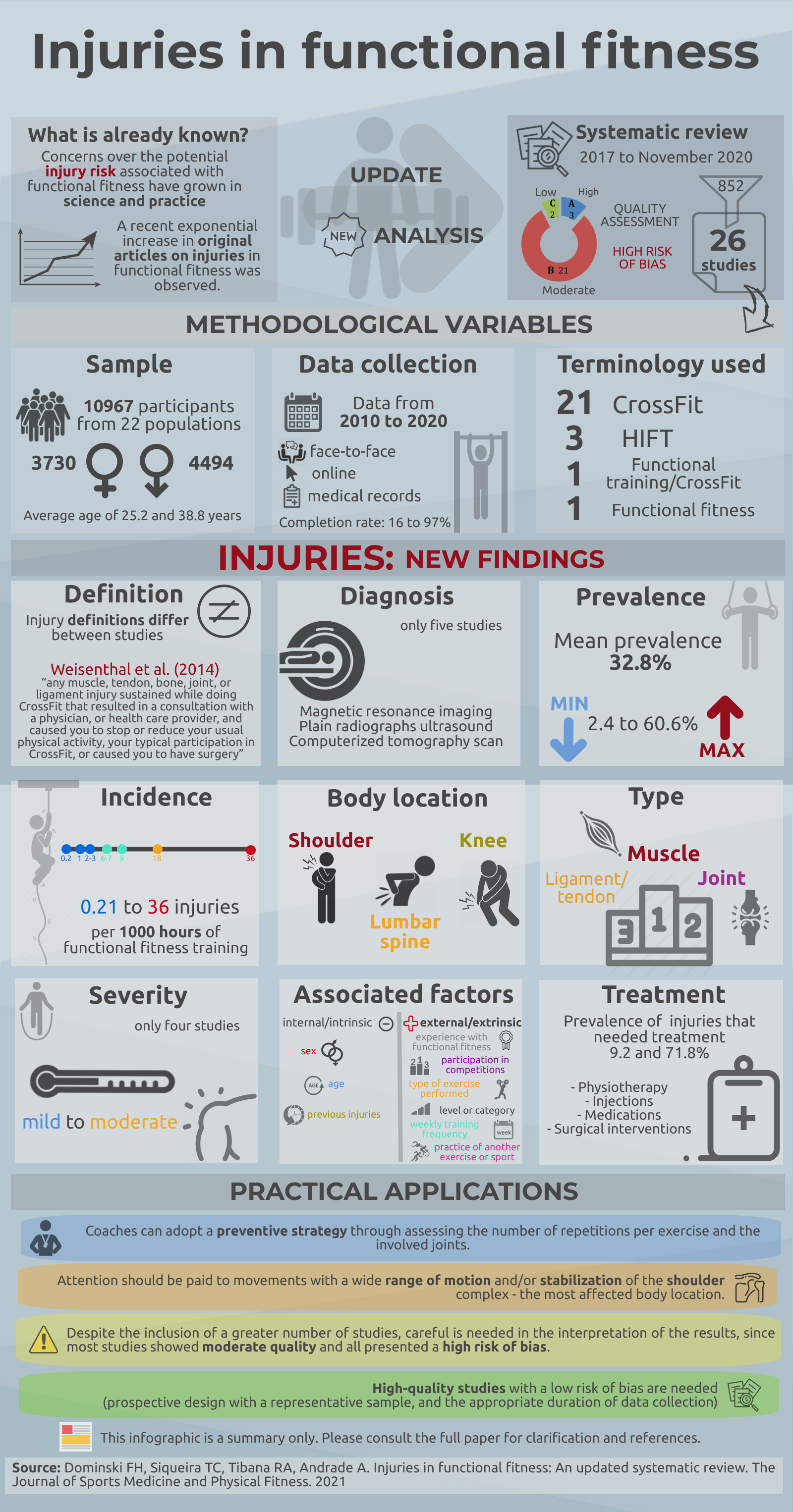Functional fitness is a real exercise ‘trend’. This practice includes varied functional movements performed at high intensity, including Olympic lifting, calisthenics, strength/power, gymnastic movements, plyometric exercises, running, and rowing. Functional fitness, also known as CrossFit® has aroused the interest of researchers due to concerns over the potential injury risk. Thus, recently we observed a substantial increase in original articles related to injuries in functional fitness.
In our recent systematic review1, in addition to the update, we expanded the scope of previous reviews on injuries in functional fitness, with new analyses such as mechanism, type, severity and treatment of injuries, as well as associated factors (experience and frequency of training, gender, age, participation in competitions, training characteristics and the practice of other exercises and sports). With a comprehensive view of the definition of injury, we found 26 studies considering the period from 2017 to November 2020. By 2017, only 10 studies had been published, which we analyzed in our previous review2. Here we offer an infographic summarising the results of our new study.

What did we find?
Most studies used a retrospective study design and the definition of injury used by the authors differed between them, however the definition most used was that provided by Weisenthal et al. (2014)3, which defines injury as “Any muscle, tendon, bone, joint or ligament injury suffered during CrossFit that resulted in a consultation with a doctor or health professional and caused you to stop or reduce your normal physical activity, your typical participation in CrossFit, or made you have surgery “.
The main variables reported were prevalence (%), body location and factors associated with injuries. The average prevalence of musculoskeletal injuries was 32.8%, ranging from 2.4 to 60.6%. Most studies reported the incidence of injuries per 1000 hours of functional fitness training, ranging from 0.21 to 36 injuries.
Only five studies described the form of diagnosis of the injuries, magnetic resonance imaging was the most frequent, followed by ultrasound and computed tomography images. Shoulders, lumbar spine and knees were the body regions identified as the most affected by the injuries presented in the included studies. Muscle, joint and ligament/tendon injuries were the type of injuries most commonly presented by practitioners of functional fitness.
In order to identify which factors could be associated with the development of injuries during and/or due to the practice of functional fitness, several variables were investigated. Experience with functional fitness has been included in a large number of studies, most of which have shown that more experienced individuals reported more injuries. Other variables such as sex, previous injuries, age, frequency of weekly training and practice of other types of exercise also showed association with injuries, but there was no consensus in the results found in view of the differences methodologies of the studies.
The severity of injuries was reported in only four studies, most of which were mild to moderate in severity. Regarding treatment, the prevalence of injuries that needed to be treated varied between 9.2% and 71.8% in the studies. Physiotherapy, injections, medications and surgical interventions were the types of treatment most used.
It is important to highlight that most of the studies included in this review had moderate methodological quality and all of them were considered to be at high risk of bias.
The results presented in this infographic have the potential to summarize the results of the most recent studies on injuries in functional fitness, as it provides information about the sample, place and period analyzed, terminology used, as well as definition of the injury used in the studies, diagnosis, prevalence (%), incidence (per 1000 hours of training), severity, type, body location, associated factors and treatment. Knowing the characteristics of the injuries reported by the studies is important in order to establish a preventive strategy in practice of functional fitness.
Authors and Affiliations:
Fábio Hech Dominski1, Thais Cristina Siqueira1, Ruy Luiz Lorenzetti Branco1, Ramires Alsamir Tibana2, Alexandro Andrade1
Correspondence to:
Dr Fábio Hech Dominski, Laboratory of Psychology of Sport and Exercise, Santa Catarina State University, Brazil. fabiohdominski@hotmail.com
- Laboratory of Sport and Exercise Psychology (Lape) of the Santa Catarina State University (Udesc) – Florianópolis (SC), Brazil.
- Graduate Program in Health Sciences, Faculty of Medicine, Federal University of Mato Grosso (UFMT), Cuiabá, Brazil.
References:
- Dominski FH, Siqueira TC, Tibana RA, Andrade A. Injuries in functional fitness: An updated systematic review. The Journal of Sports Medicine and Physical Fitness. 2021
- Dominski, F. H., Siqueira, T. C., Serafim, T. T., & Andrade, A. (2018). Injury profile in CrossFit practitioners: systematic review. Fisioterapia e Pesquisa, 25(2), 229-239.
- Weisenthal BM, Beck CA, Maloney MD, DeHaven KE, Giordano BD. Injury Rate and Patterns Among CrossFit Athletes. Orthop J Sports Med. 2014; 2:2325967114531177
Competing interests: None declared.